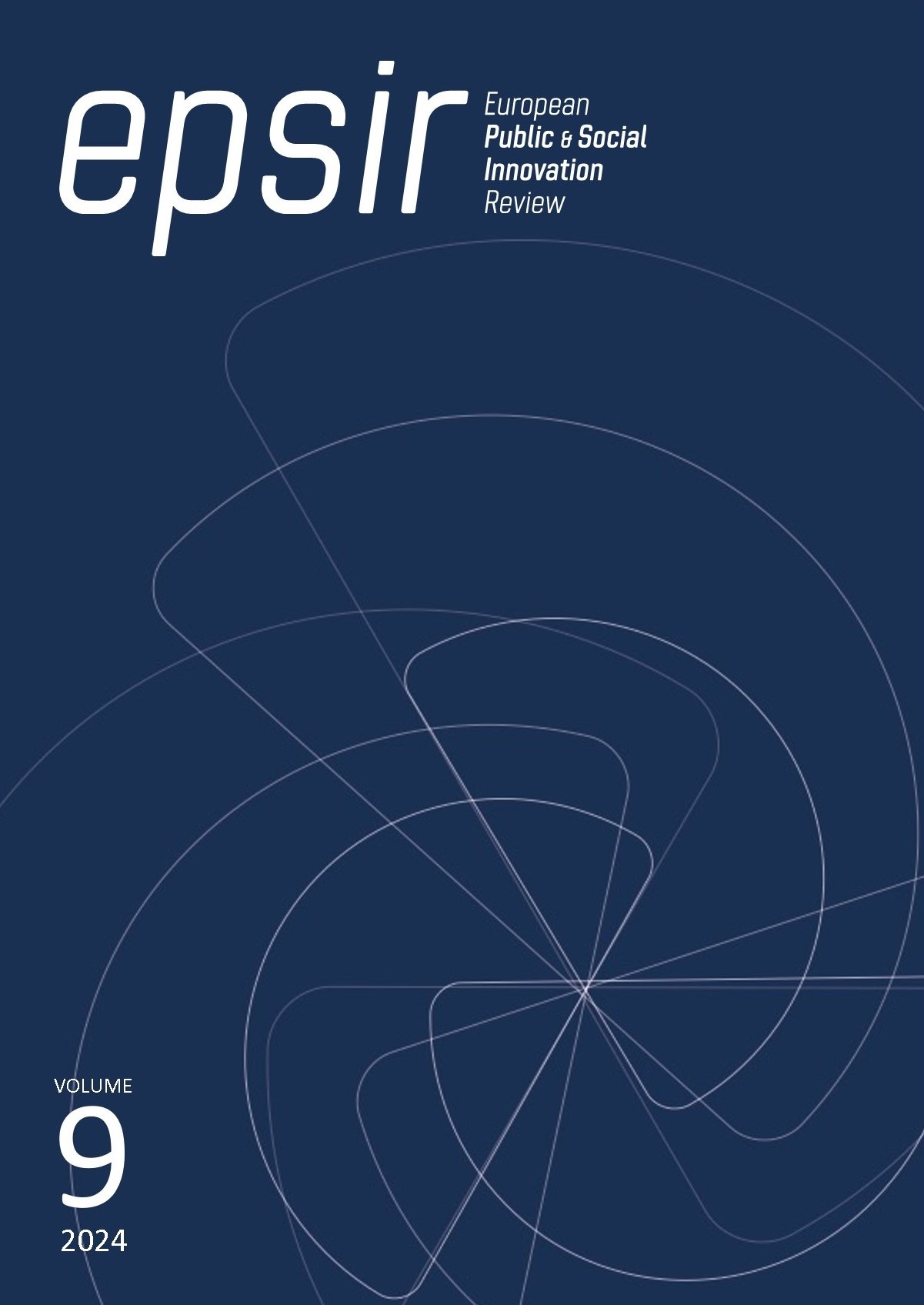Fronteras Socioemocionales de la IA: Influencia de las Conexiones 6.0
DOI:
https://doi.org/10.31637/epsir-2024-1144Parole chiave:
Inteligencia artificial, Ética, Bienestar social, Cognición, Pensamiento crítico, Conexiones, Fronteras socioemocionales, HabilidadesAbstract
Introducción: La conexión refiere velocidad, cantidad de dispositivos, capacidad tecnológica, transformación digital, desarrollo de habilidades y factores éticos. La velocidad se suma a la conexión y demanda manejo de datos en la transmisión, ancho de banda, fiabilidad en tráfico de información de dispositivos y número de usuarios. La Inteligencia Artificial aporta a la resolución de problemas y ejecución de tareas; cuestionando el sentido lógico-racional: ¿Cómo hacer que este tipo de inteligencia sea más amigable? Metodología: El enfoque es cuantitativo e implica una recolección sistemática de información, mediante encuesta aplicada a la muestra de estudio; 16 docentes y 32 estudiantes del programa de contaduría en la UDEC, para efectuar un análisis descriptivo. Resultados: Indagando en la IA, uso, riesgos, implicaciones éticas y fronteras emocionales según la evolución de las conexiones 6.0. Se observa coacción del pensamiento crítico, vulnerabilidad de la ética y dependencia tecnológica. Discusión: Lo socioemocional destaca autoconocimiento, autorregulación, empatía, autoconfianza, escucha activa, actitud responsable, resiliencia y percepción de experiencias. Conclusiones: la influencia de las conexiones lleva a nuevas necesidades y creación de elementos que optimicen tiempos de trabajo y productividad en el quehacer académico, sin embargo, en cierta medida, se da abstracción del mundo real y fronteras emocionales.
Downloads
Riferimenti bibliografici
Abeliuk, A. y Gutiérrez, C. (2021). Historia y evolución de la inteligencia artificial. Revista Bits de Ciencia, 21, 14-21. https://revistasdex.uchile.cl/index.php/bits/article/view/2767/2700
Asencio, G. G., Sánchez, P. M., Gómez, M. J., Contreras, V. A., Medina, R. M., Coto, L. E., López, P. D. y Aguilar, M. E. (2023). Libro de memorias proyecto de investigación latinoamericano 100 investigadores “IA en las aulas: Un estudio multidisciplinario sobre su influencia en el proceso docente”. Ciencia Latina. https://doi.org/10.37811/cli_w1011 DOI: https://doi.org/10.37811/cli_w1011
Becerra, S. L. (2020). Tecnologías de la información y las comunicaciones en la era de la cuarta revolución industrial: Tendencias tecnológicas y desafíos en la educación en ingeniería. Entre Ciencia e Ingeniería, 14, 76-81. https://doi.org/10.31908/19098367.2057 DOI: https://doi.org/10.31908/19098367.2057
Bolaño, M. y Duarte, N. (2023). Una revisión sistemática del uso de la inteligencia artificial en la educación. Revista Colombiana de Cirugía, 39, 51-63. https://doi.org/10.30944/20117582.2365 DOI: https://doi.org/10.30944/20117582.2365
Callon, M., Courtial, J. P. y Laville, F. (1991). Co-Word analysis as a tool for describing the network of interactions between basic and technological research: the case of polymer chemistry. Scientometrics, 22(1), 155-205. https://doi.org/10.1007/BF02019280 DOI: https://doi.org/10.1007/BF02019280
Fadel, C. y Groff, J. (2019). Four-dimensional education for sustainable societies. En Sustainability, human well-being, and the future of education (pp. 269-281). Palgrave Macmillan. https://doi.org/10.1007/978-3-319-78580-6_8 DOI: https://doi.org/10.1007/978-3-319-78580-6_8
Flores, V. J. y García, P. F. (2023). Reflexiones sobre la ética, potencialidades y retos de la Inteligencia Artificial en el marco de la Educación de Calidad (ODS4). Comunicar: Revista científica de comunicación y educación, 31(74), 37-47. https://acortar.link/S31KP4 DOI: https://doi.org/10.3916/C74-2023-03
Future Trends Forum. (2023). Quantum Computing e Inteligencia Artificial: la revolución silenciosa. Fundación Innovación Bankinter. https://acortar.link/LoJe7d
Grassini, S. (2023). Shaping the future of education: exploring the potential and consequences of AI and ChatGPT in educational settings. Education Sciences, 13(7), 692. https://acortar.link/EljM3q DOI: https://doi.org/10.3390/educsci13070692
Iso. (2024). ¿Qué es la inteligencia artificial (IA)? https://www.iso.org/es/inteligencia-artificial/que-es-ia
Miailhe, N. y Lannquist, Y. (2018). Un desafío de gobernanza mundial: Algoritmolandia inteligencia artificial para una integración predictiva e inclusiva de América Latina. Integración y Comercio, 44, 218-231. https://dialnet.unirioja.es/servlet/articulo?codigo=6551945
Moreno, R. (2019). La llegada de la inteligencia artificial. RiTI, 7(14), 270-280. https://doi.org/10.36825/RITI.07.14.022 DOI: https://doi.org/10.36825/RITI.07.14.022
Morín, E. (2018). De la reforma universitaria. http://beu.extension.unicen.edu.ar/xmlui/handle/123456789/275 DOI: https://doi.org/10.22201/fq.18708404e.1998.3.66556
Organización de las Naciones Unidas para la Educación, la Ciencia y la Cultura. (2019). Habilidades socioemocionales en América Latina y el Caribe. Estudio Regional Comparativo y Explicativo (ERCE 2019). https://unesdoc.unesco.org/ark:/48223/pf0000380240
Organización de las Naciones Unidas para la Educación, la Ciencia y la Cultura. (2020). El aprendizaje socioemocional como factor fundamental para la educación. https://ourl.io/cSK06
Organization for Economic Co-operation and Development. (2020). Better Policies for lives – Learning Compass. https://www.oecd.org/en/data/tools/oecd-learning-compass-2030.html
Pérez, C. (2004). Revoluciones tecnológicas y capital financiero. La dinámica de las grandes burbujas financieras y las épocas de bonanza. S. XXI Editores. https://ourl.io/yeyms
Rouhiainen, L. (2018). Inteligencia artificial: 101 cosas que debes saber hoy sobre nuestro futuro. Editorial Alienta. https://ourl.io/sWKSo
Solórzano Álava, W. L., Rodríguez Rodríguez, A., Anzules Ávila, X. L. y Mar Cornelio, O. (2022). Redes inalámbricas, su incidencia en la privacidad de la información. Journal TechInnovation, 1(2), 104-109. https://revistas.unesum.edu.ec/JTI/index.php/JTI/article/view/25/42 DOI: https://doi.org/10.47230/Journal.TechInnovation.v1.n2.2022.104-109
Tomalá, M. A., Mascaró, E. M., Carrasco, C. G. y Aroni, E. V. (2023). Incidencias de la inteligencia artificial en la educación. Recimundo, 7(2), 238-251. https://doi.org/10.6018/educatio.555681 DOI: https://doi.org/10.26820/recimundo/7.(2).jun.2023.238-251
Transparencia por Colombia. (2005). Código de Ética Corporación Transparencia por Colombia. https://acortar.link/bEJerW
Universidad de Cundinamarca. (2015). Finalidades del tratamiento. En Manual de políticas de seguridad y privacidad de la información. https://acortar.link/HmHHGl
Downloads
Pubblicato
Come citare
Fascicolo
Sezione
Licenza
Copyright (c) 2024 Jenny Jazmín Gómez Murcia

Questo lavoro è fornito con la licenza Creative Commons Attribuzione - Non commerciale - Non opere derivate 4.0 Internazionale.
Authors who publish with this journal agree to the following terms:- Authors retain copyright and grant the journal right of first publication with the work simultaneously licensed under Creative Commons Non Commercial, No Derivatives Attribution 4.0. International (CC BY-NC-ND 4.0.), that allows others to share the work with an acknowledgement of the work's authorship and initial publication in this journal.
- Authors are able to enter into separate, additional contractual arrangements for the non-exclusive distribution of the journal's published version of the work (e.g., post it to an institutional repository or publish it in a book), with an acknowledgement of its initial publication in this journal.
- Authors are permitted and encouraged to post their work online (e.g., in institutional repositories or on their website) prior to and during the submission process, as it can lead to productive exchanges, as well as earlier and greater citation of published work (See The Effect of Open Access).



